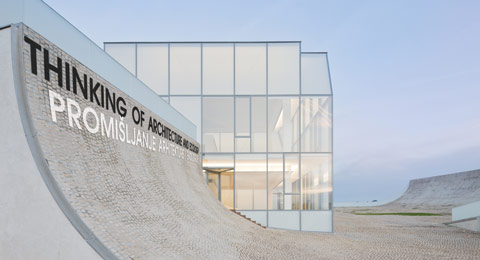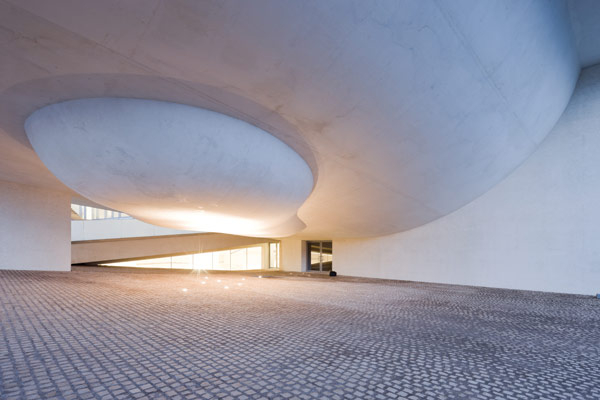Čini se da emocionalna iskustva koja budi Hollov muzej pokreću značajne teme pročišćene estetike i „čišćenja“ planete.
Autor: Steven Holl Architects i Solange Fabião
Projekat: Cité de l’Océan et du Surf
Lokacija: Biarritz, Francuska
Tekst: Gordana Petković, dipl. ing. arh.
Bela boja u arhitekturi doživela je prepoznavanje kroz simboliku jednostavnosti u estetici modernizma koji je popularizovao „belu“ arhitekturu i od tada pa do savremenog arhitektonskog stvaralaštva postoji tendencija da se čitavi arhitektonski koncepti neke građevine zasnivaju na značenjskim i vizuelnim karakterisitkama belog.
Transparentnost omogućava da se unutrašnji „svet“ građevine integriše u svet izvan i tako komunicira i sa prolaznicima, a ne samo sa korisnicima. Na taj način arhitektura postaje istovremeno i „živa“ skulptura.
Deluje jedino moguće da objekti budu statične tvorevine, a ipak arhitektura se može ostvariti kao dinamička struktura, zahvaljujući skulptorskom oblikovanju, koje tretira ne samo masu, već i prostor oko mase stvarajući pokret.
Muzej Cité de l’Océan et du Surf Stevena Holla nenametljivo koristi vizuelni rečnik – belo, transparentno, u pokretu da dočara svoju namenu i sa druge strane da ostvari skladan odnos sa prirodnim okruženjem. Izbor arhitektonskih sredstava proističe iz paralelnog promišljanja – umetničkog i naturalističkog.
Objekat muzeja je smešten na francuskoj obali Atlantskog okeana, uz plažu koja ima istoriju turizma još od kraja XIX veka. Nasuprot pomalo napadnom dekorativnom stilu velikih javnih objekata iz perioda Belle Epoque, muzej izraženo teži minimalizmu. Svojom urbanističkom / pejzažnom postavkom i formom istražuje oblasti mora i surfovanja i njihovo značenje u (fizičkoj i duhovnoj) relaksaciji, ekologiji i nauci. Potreba da se muzej posveti na ovaj način okeanu – kroz osvešćivanje po pitanju zagađenja i održivosti najvećih vodenih površina na planeti, proširivanje znanja o bogatstvu okeanskih dubina i poštovanje ljudske sposobnosti da se uhvati u koštac sa silinom i misterioznošću okeanskih talasa, odraz je drugačijeg stava prema korišćenju prirodnih resursa i drugačijeg odnosa prema životnim vrednostima, koji, na žalost nisu preovlađujući u današnjem svetu. I ideja i realizacija ovog objekta predstavljaju doprinos pokušaju razbuđivanja svesti i popularizaciji principa izbalansiranog koegzistiranja prirode i čoveka.
Arhitektonski dizajn Stevena Holla u saradnji sa brazilskim arhitektom Solange Fabiãom izabran je na internacionalnom konkursu održanom 2005. godine. Muzej je otvoren za posetioce u junu 2011. godine.
Forma objekta proizilazi iz prostornih odnosa, koje Holl definiše kao sve ono što je „pod nebom“ i „pod morem“, a koji potcrtavaju značaj nebeskog svoda i okeana u autorovom shvatanju života i arhitekture. Arhitektonsko rešenje koje zapravo oblikuje čitav prostor, kombinacija je otvorenih i zatvorenih prostora, bez jasno definisane granice između spoljnjeg i unutrašnjeg. Princip integrisanosti – izgrađenih struktura sa topografijom terena, ugrađenih prirodnih materijala i lokalne vegetacije zapravo potiče iz težnje vrhunskom idealu sjedinjavanja plaventila vode i plavetnila neba na liniji horizonta. Konkavna forma pratećeg platoa odgovara na simboliku otvorenog (slobodnog) prostora pod nebom, dok konveksne krovne ravni izložbenih prostora sasvim očito parafraziraju formu talasa, ispod koga se odvija bogati podvodni život (preneto u arh tektonski prostor – inspirativne izložbene postavke). Motiv dva staklena kubusa pandan je paru stena koji se vidi u daljini na plaži. U jednom od njih se nalazi restoran, a u drugom skladište za surfere. Noću oni svetle i tako postaju svojevrsni svetionici – orijentiri na kopnu. Zajedničke karakteristike neba i vode, a to su prostranost, prelamanje svetlosti, prozračnost asocijativno su implementirane u materijalizaciju objekta. Preovlađuju staklo, beli beton od agregata iz južne Francuske i neobrađeni kamen iz Portugala. I u materijalizaciji enterijera prisutan je isti minimalistički tretman. Zidovi i plafon glavnog korpusa obrađeni su u gipsu bele boje tako da stvaraju svedeni ambijent za izložbene postavke, dok pod od svetlog drveta daje neophodni osećaj prirodnosti i topline.
Inspiracija surfovanjem, osim što se sama nametnula zbog konteksta i namene muzeja, proističe i iz Hollove strasti za ovim sportom. Zakrivljena platforma, usmerena ka horizontu podseća na talas koji iznosi surfera iznad površine okeana. Celokupan doživljaj ostvaruje se iz odnosa u kome arhitektonska lepota komunicira sa plavenilom okeana i neba.
Objekat muzeja je nastao kao vešt produkt imaginacije inspirisane tajanstvenim prirodnim svetovima sa jedne i svetovima mašte sa druge strane. Uspešnost autorskog tima može se meriti time što građevina sama po sebi nosi istu poruku koju ima i po svojoj osnovnoj nameni – kao kuća inspirišućih i edukativnih muzejskih postavki. It appears that the effects of the Steven Holl’s Museum open important themes – purified aesthetics and “cleansing” of the planet.
Architects: Steven Holl Architects and Solange Fabião
Project: Cité de l’Océan et du Surf
Location: Biarritz, France
Text: Gordana Petković, B. Arch.
White colour in architecture has been recognized as a symbol of simplicity and purity in aesthetics of modernism which popularized the “white” architecture. Since then, the tendency exists to base whole architectural concepts on semantic and visual features of white.
Transparency allows the inner “world” of the building to integrate into the world outside and to communicate not only with its users but also with passers-by. Thus architecture becomes “living” sculpture.
It seems only possible that objects can be static formations, yet architecture can be realized as a dynamic structure, thanks to the sculptural design, which treats not only the mass but also the space around the mass, creating movement.
Steven Holl’s Museum Cité de l’Océan et du Surf uses unobtrusively visualised dictionary – white, transparent, in movement to conjure up its purpose and, on the other hand, to achieve a harmonious relationship with the natural environment. The choice of architectural resources is a result of parallel thinking – artistic and naturalistic.
The building of the Museum is located on the French Atlantic coast, along the beach which has been a tourist resort since the late nineteenth century. In contrast to the decorative style of large public buildings from the Belle Epoque period, the Museum strives conspicuously to minimalism. Urban and landscape features and form of the Museum explore surrounding elements – ocean and surfing and their significance for physical and spiritual relaxation, ecology and science. The need to devote the museum to ocean – through awakening of ideas regarding pollution and the sustainability of the largest aquatic areas on the planet, expanding knowledge of the richness of ocean depths and recognition of human ability to cope with the force and mysteriousness of ocean waves, is a reflection of different attitude on the use of natural resources and a different attitude towards life values, which, unfortunately, are not prevalent in today’s world. Both, the idea and the realization of this structure contribute to the attempt of awakening the consciousness and the popularization of the principles of balanced coexistence of nature and men.
The architectural design of Steven Holl and associate Brazilian architect Fabiãom Solange was awarded at an international competition held in 2005. The museum was opened to public in June, 2011.
The form of the building is the outcome of the relations between the spaces, which Holl defines as everything that is “under the Sky” and “under the Sea”, and which highlight the importance of the sky and ocean in the author’s understanding of life and architecture. The architectural solution, shapes the entire space. It represents a combination of open and closed space, with no clearly defined boundaries between inside and outside. The principle of integration – built structures within the topography of the terrain, incorporation of natural materials within local vegetation, stems from the pursuit of the ultimate ideal – uniting the blueness of the water and the blueness of the sky on the horizon. Concave form of the plateau corresponds to the symbolism of the open space under the sky, while the convex form of the roof planes of the exhibition areas, obviously, paraphrase sea wave, beneath which, the rich underwater life unfolds (transferred to the architectural space – inspiring exhibitions). The motive of the two glass cubes is equivalent to the pair of rocks that can be seen in the distance on the beach. A restaurant is placed in one and the other contains storage for surfers. At night, the cubes light up and thus become beacons – landmarks on the mainland. Common features of the sky and water – vastness, refraction of light, and transparency, are associatively implemented in the materialization of the object. Dominate materials are glass, white concrete made of aggregates from southern France and raw stone from Portugal. Materialization of interior also has the same minimalist treatment. The walls and ceilings of the main corpus are covered in white plaster to create a purified ambient for exhibitions, while the light-wood floors give a necessary sense of naturalness and warmth.
Surfing – the element of inspiration, beside the fact that it is imposed by context and purpose of the museum, also derives from Holle’s passion for this sport. The curved platform, focused on the horizon, resembles the wave which raises a surfer above the ocean surface. The whole experience arises from the relationship – communication of the architectural beauty and the blueness of the ocean and the sky.
The building of the museum is a skillful product of imagination, inspired by the mysterious natural worlds on one hand, and by worlds of imagination on the other. The success of the authors team can be measured by the fact that the building itself carries the message of its primary purpose – it is the house of inspiring and educational museum settings.










